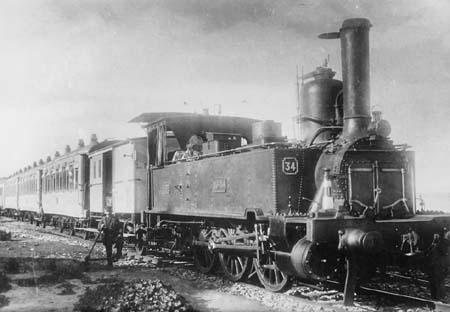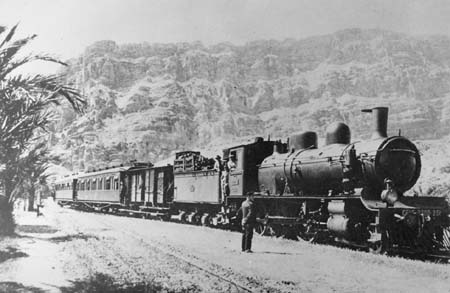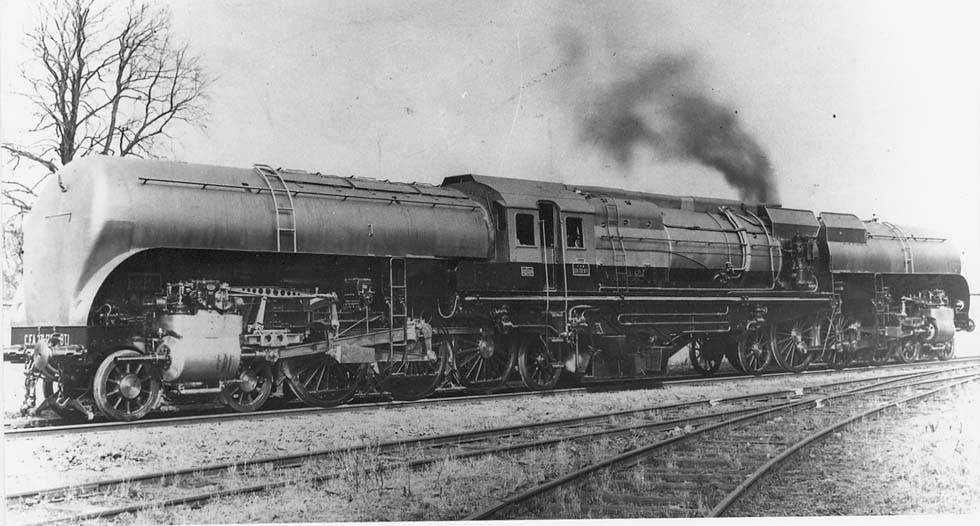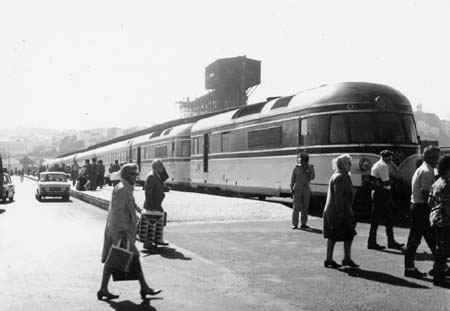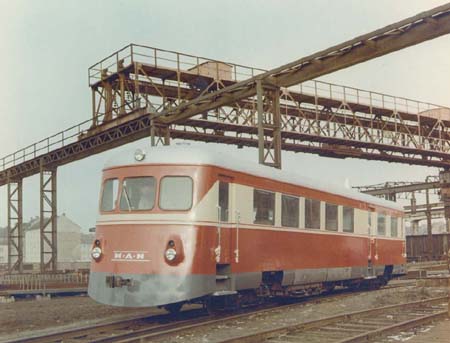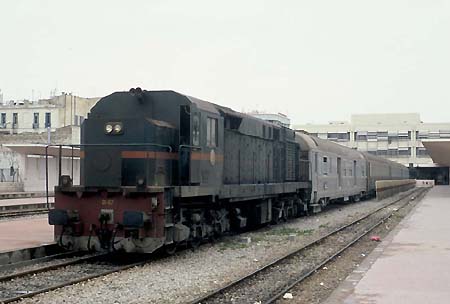|
M a g h r e b
The Maghreb had been the pride of "La Fance d' Outre-Mer" and its first railway was inaugurated in 1862 at Alger. France created modern railway networks in Algeria and Tunesia, standard gauge and east of Tunis meter gauge. In Morocco initially only 0.60 m gauge military tracks had been built. Then the standard gauge expresses, also with CIWL sleepers and diners, started at Tunis, Alger, Oran, Tanger and Casablanca. On the other side of the Mediterranean, the ships connected with the specials at Marseille Joliette, Port-Vendres, the expresses at Algeciras and the Sud-Express at Lisbon. Only in 1902 Wagons-Lits offered a round-trip service by luxury trains and steamers from Paris via Palermo to Tunesia, Algeria, Cartagena, Madrid and from there to Paris by the Sud-Express. Under political pressure a service Tunesia - Algeria was established by the de-Luxe Tunis - Constantine - Oran with old Orient-Express type sleepers, now painted white. That unpopular express, known as "le Train blanc", vanished after a few months. Another tourist train is shown on a well-known postcard: A 141-LT tank locomotive starts at Casablanca quai with a CFM special for tourists, not a regular boat-train. The picture had been taken before World War II, when the station Casablanca port not yet existed. In 1934 the standard gauge between Algeria and Morocco was completed. The expresses Alger - Oran, hauled by the fantastic Garratts 231-132-AT, then BT, had cars for the express Oran - Casablanca, in Morocco hauled by P.O. type Mikados 141-A, built in Poland. Still in 1942 blue CIWL sleepers ST connected Tanger with Casablanca, Casablanca with Oujda and Alger with Constantine. After interruption, in 1946 the night expresses Oran - Alger and Alger - Constantine started again. The Wagons-Lits timetable e.g. in 1951 showed sleeping-cars ST Tanger - Casablanca and in the express MA/AM Casablanca - Alger, from 1952 only to Oujda. Already in 1957 new diesel railcar sets had been built, a derivative of the French RGP, consisting generally of five yellow/red cars with bar and reclining seats and two engine units. Equipped also with a sleeping-car, they were intended for services Casablanca - Oran, with boat connection to Port Vendres, thus providing a fast link with Paris. Independence prevented it and only in 1961 they went into service Tanger - Casablanca as day trains TC/CT, later hauled by diesel and electric locomotives. The isolated railway at Ceuta had German railcars. In summer 1975 started the Transmaghreb, proudly announced as "liaison rapide Tunis - Alger - Casablanca". American diesels hauled the stainless Inox cars which did run from Tunis to Alger. Traffic from Algeria to Oujda, the border station of Morocco, however was interrupted soon and ten hours late-running was reported. In 1989 a Transmaghreb really ran from Alger to Oujda, consisting of a blue General Motors diesel and 11 grey cars, including even a diner. Then it was interrupted again and also the services from Tunesia to Algeria were stopped. Only the night express from Oujda to Casablanca port still carried the proud name "Al Maghreb al Arabi". Quite another train was created on Tunesian meter gauge: the tourist special "Lezard Rouge" with a wooden saloon from the Bey's personal de-Luxe. For ferries crossing the Strait of Gibraltar see www.ships-worldwide.com. Chronology 1871: Alger - Oran completed, 1911 to Oujda 1884: Algeria connected with Tunesia at Ghardimaou 1902: CIWL all-sleeper de-Luxe Tunis - Constantine - Alger - Oran, only a few months. 1906: Oran - Colomb-Bèchar completed, 1.055m gauge. 1912: Tunis - Sfax completed, 1 m gauge 1921: Casablanca - Oudja completed, 0.60m gauge 1927: Tanger - Casablanca completed, 1928 to Marrakech 1934: Express Oran - Oujda - Casablanca, interrupted by WWII, then AM/MA Alger - Casablanca, stopped in 1962 1961: TC/CT diesel railcar sets Tanger - Casablanca 1975: Transmaghreb Tunis - Alger, until c. 1996 1976: Oran - Oujda stopped, in 1989 resumed, towards stopped 2000 again. Train de Luxe Tunis - Constantine - Alger - Oran CIWL de-Luxe, standard gauge, only 1902: 1 Fourgon (van), 3 WL (sleepers) 1 WR (restaurant), 1 van. Colors: white (cream). CIWL WL 82,83 and 85, 6-wheelers, Rathgeber 1881/82. WR 6-wheeler with center-located kitchen, details not known. A 6-wheeled WR 115 burnt out at Oran in 1893. The other cars of this Rathgeber series 114-116, painted white (for Argeria?) stayed in Spain from 1887 (according to Aranguren). Could the destroyed 115 have been built-up for the Tunis-Oran-Express? Vans F1134, 1135, 4-wheelers ex-PLM. The only pictures show 0-6-0 tank engine no. 34 of Bone-Guelma. Connection by Naples-Palerme-Express (with sleepers from Berlin and Paris), Société de Navigation Generale Italienne Palermo - Tunis, Société Générale Transatlantique Oran - Cartagena, CIWL WL Cartagena - Madrid, Sud-Express to Paris. CIWL For CIWL cars in the the Maghreb there is no complete list. George Behrend mentioned in "History of Trains de Luxe" for Algeria WL 428-430, 432, 638, 2694 (ST), 2904-2911 (S1), WR 230, 232, 297, 299, 813-814, 1606, WR ex WSP 2742-2744, F1134-1135; for Morocco WL 1624-1625, 1724; for Tunesia WR 996-997 (4-wheelers, later bogies). Colors: varnished teak, all-steel cars dark blue. Traction Expresses between Tunesia, Algeria and Morocco: Bone-Guelma: 0-6-0. CFT: from 1914 Pacifics. CFT/SNCFT: diesel from 1946 Est-Algerien/CFAE: 4-6-0 from 1904, 4-8-2 from 1932. PLM/CFA: 0-6-0, 4-6-0 types form 1899, various 4-6-2+2-6-4 Garratts from 1932 for expresses Alger - Oran (- Casablanca),out of service in 1951. SNCFA/SNTF: Diesel from 1947. CFM: 4-6-0 ex PO, Mikados 141-A from 1932 for express (Oran) Oujda-Casablanca. CFM/ONCF: Diesel from 1947, partial electrification started in 1927, initially Midi type BB, then 3kV dc. Transmaghreb SNCFT, standard gauge, Tunis 1987 (according to H.H. Frohn)
Colors: Locomotive dark-green, coaches stainless Its successor in autumn 1996 ran only from Tunis to Ghardimaou, consisting of a 060BN (CoCo, GE), which hauled two motorless light-blue/grey Ganz-Mavag diesel railcar sets. Locomotives dark-green, then dark-blue/red. OC Oujda - Casablanca Voyageurs ONCF, standard gauge, departure Fez, Feb. 15, 1998:
Colors: light-yellow/red. 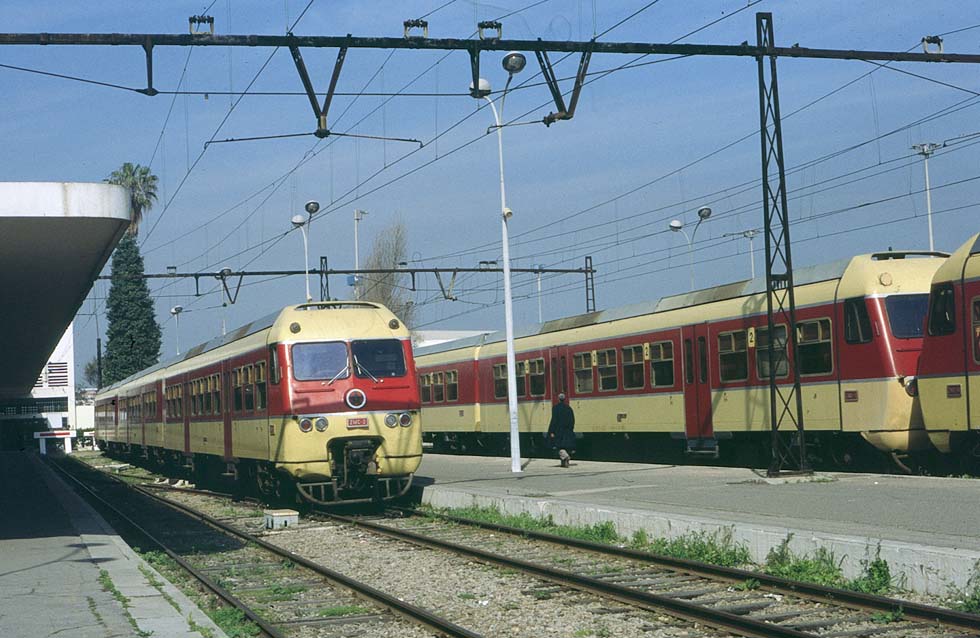 Navette Rapide airport connection, Casablanca Port, 1998 (WS)
Download this picture with 1500 x 1000 pix, 300 dpi
High-Speed At a time when high-speed studies in Latin America, e.g. Mexico – Guadalajara, Rio – Sao Paolo or Buenos Aires – Cordoba, were still a dream, the Kingdom of Morocco advanced. Studies for a high-speed line from the harbour city Tanger to Marrakech started years ago, a tunnel beneath the Strait of Gibraltar had become a Spanish dream and a high-speed line to Algeria, Tunisia or even Libya was a fantasy, politically unrealistic. The high-speed line from Tanger to Kenitra on the way to Casablanca has been announced to be completed in 2018. Alstom TGV 2N2 Duplex train sets are to arrive at a futuristic railway station, designed by Silvio d’Ascia, Omar Kobite and Eric Giudice Architects. Also a line from Marrakech westward to the Atlantic coast became evaluated.
| ||||||||||||||||||||||||||||||||||||||


